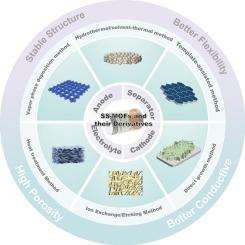Self-supporting metal-organic frameworks (MOFs) and their derivatives for lithium-sulfur batteries: a comprehensive review
IF 23.5
1区 化学
Q1 CHEMISTRY, INORGANIC & NUCLEAR
引用次数: 0
Abstract
In response to the increasing energy demand and growing awareness of environmental concerns, lithium‑sulfur batteries (LSBs) have attracted considerable attention as a promising alternative to conventional batteries, primarily due to their high energy density. However, challenges such as the shuttle effect of lithium polysulfides (LiPSs), electrode volumetric expansion, and lithium dendrite formation negatively affect their practical lifespan. Self-supporting Metal-Organic Frameworks (SS-MOFs) and their derivatives, known for their high electrical conductivity and porosity, present potential solutions by mitigating the shuttle effect, thereby enhancing the energy density, cycling stability, and energy efficiency of LSBs. This review initially elucidates the operating principles and challenges associated with LSBs, subsequently focusing on the structural classification, design and preparation methodologies, and the role of SS-MOFs in LSBs, including their application in the cathode, separator, anode, and electrolyte. The review aims to address current challenges and propose developmental opportunities to facilitate the advancement and commercialization of LSB technology.


锂硫电池用自支撑金属有机骨架及其衍生物综述
为了应对日益增长的能源需求和日益增长的环保意识,锂硫电池(lsb)作为一种有前途的传统电池替代品引起了相当大的关注,主要是因为其高能量密度。然而,诸如多硫化锂(LiPSs)的穿梭效应、电极体积膨胀和锂枝晶形成等挑战对它们的实际寿命产生了负面影响。自支撑金属有机框架(SS-MOFs)及其衍生物以其高导电性和高孔隙率而着称,通过减轻穿梭效应,从而提高LSBs的能量密度、循环稳定性和能量效率,提供了潜在的解决方案。本文首先阐述了LSBs的工作原理和面临的挑战,然后重点介绍了结构分类、设计和制备方法,以及SS-MOFs在LSBs中的作用,包括它们在阴极、分离器、阳极和电解质中的应用。检讨的目的是解决当前的挑战,并提出发展机会,以促进LSB技术的进步和商业化。
本文章由计算机程序翻译,如有差异,请以英文原文为准。
求助全文
约1分钟内获得全文
求助全文
来源期刊

Coordination Chemistry Reviews
化学-无机化学与核化学
CiteScore
34.30
自引率
5.30%
发文量
457
审稿时长
54 days
期刊介绍:
Coordination Chemistry Reviews offers rapid publication of review articles on current and significant topics in coordination chemistry, encompassing organometallic, supramolecular, theoretical, and bioinorganic chemistry. It also covers catalysis, materials chemistry, and metal-organic frameworks from a coordination chemistry perspective. Reviews summarize recent developments or discuss specific techniques, welcoming contributions from both established and emerging researchers.
The journal releases special issues on timely subjects, including those featuring contributions from specific regions or conferences. Occasional full-length book articles are also featured. Additionally, special volumes cover annual reviews of main group chemistry, transition metal group chemistry, and organometallic chemistry. These comprehensive reviews are vital resources for those engaged in coordination chemistry, further establishing Coordination Chemistry Reviews as a hub for insightful surveys in inorganic and physical inorganic chemistry.
 求助内容:
求助内容: 应助结果提醒方式:
应助结果提醒方式:


